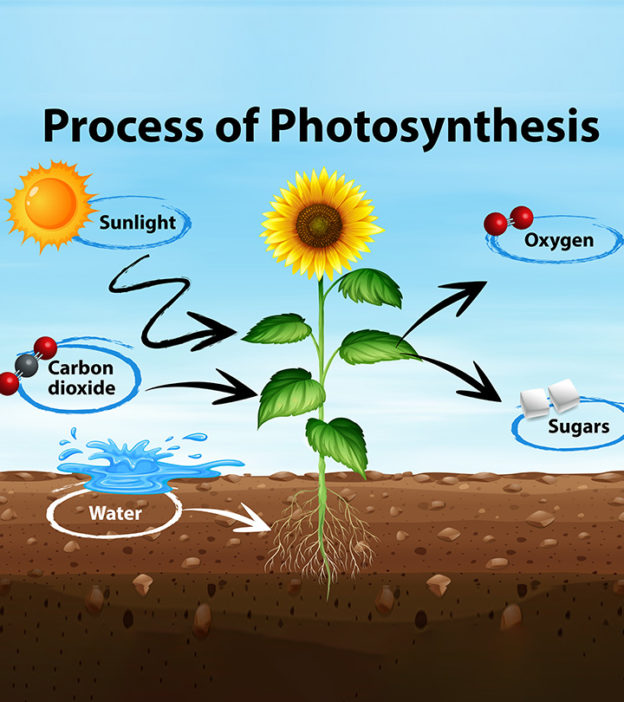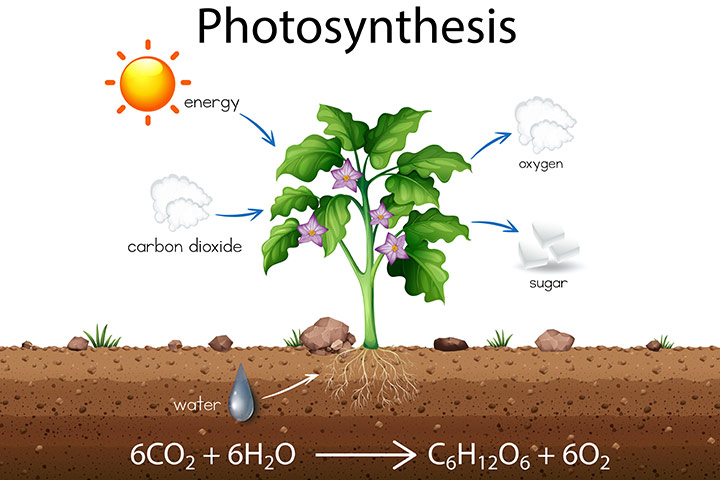Photosynthesis Diagram Easy Photosynthesis Diagram for Kids

Image: Shutterstock
Did you know plants make their food? Wondering how?
To introduce the process of photosynthesis for kids, you should make them understand its meaning and benefits. Photosynthesis is a term formed by 'photo' and 'synthesis.' 'Photo' means light, while 'synthesis' means producing something. It is the process by which plants make their food using sunlight, water, and carbon dioxide. During photosynthesis, plants convert carbon dioxide and water into glucose and oxygen in the presence of sunlight. This oxygen goes into the atmosphere and gives life to other living organisms. The process of photosynthesis makes plants an important part of the ecosystem, without which life on earth is impossible. Read on to explain the process of photosynthesis and related facts for children.
Process Of Photosynthesis
For photosynthesis, plants need three elements:
- Water
- Sunlight
- Carbon dioxide
Once a plant gets these three materials, it starts collecting them.
- Carbon dioxide is absorbed through small pores or holes called stomata in the leaves.
- Water is absorbed by the roots and is passed through the stem on the way to the leaves.
- Sunlight is absorbed by a green chemical called chlorophyll, which is present in the leaves.
The process of photosynthesis takes place in the leaves, which are made of tiny cells. Each cell contains a structure called the chloroplast that has chlorophyll. It is the chemical that gives green color to the leaves.
After absorbing these three elements, leaves use the sunlight's energy to split water molecules into hydrogen and oxygen. Hydrogen and carbon dioxide combine to form glucose, which is a form of sugar, and oxygen is released into the atmosphere.
There are two phases in photosynthesis—
Image: Shutterstock
1. Light-dependent reactions
As the name suggests, these reactions can occur only when light is available to the plant. It helps to convert light energy into chemical energy. Chloroplasts capture sunlight and convert it into two forms of energy storage — ATP and NADPH — used to create sugar in the second phase.
2. The Calvin cycle
The phase is named after the scientist Melvin C. Calvin, who discovered this process. In this cycle, reactions can occur even at night. The plant doesn't require sunlight for this part of the process. This cycle requires ATP and NADPH produced in the light-dependent reactions for preparing glucose.
30 Photosynthesis Facts For Kids
- Photosynthesis enables plants to absorb energy from the sun.
- Glucose is not just a form of energy. Plants use glucose to build starch and cellulose.
- Chlorophyll absorbs blue and red wavelengths of light and reflects green. Hence, leaves appear green to our eyes.
- Algae and some bacteria can also use photosynthesis to create energy.
- There are different molecules in chlorophyll that absorb different colors. Hence, some leaves might appear red, purple, or gold.
- When six molecules of carbon dioxide and six molecules of water come together, they make one molecule of glucose and six molecules of oxygen.
- Cellular respiration is a technique through which the plant turns the energy from the sun into a usable form for both plants and animals.
- Cellular respiration uses oxygen and sugar and releases carbon dioxide and water.
- There is more than one type of photosynthesis. They are aerobic and anaerobic.
- The whole structure of a plant is made to support photosynthesis.
- Most life on earth is dependent on photosynthesis.
- The stomata release oxygen and water vapor.
- A network of vessels called 'xylem' within the stem of a plant enables transporting water from the roots to the leaves.
- Phloem are vessels present in the stem that carry energy from the leaves to other parts of the plant.
- Excess sugar is stored in the roots in the form of starch.
- Carotenoids are red-, yellow-, and orange-colored pigments that absorb blue and green light.
- Phycobilins are red and blue pigments found in algae and cyanobacteria.
- English clergyman and scientist Joseph Priestley first started studying photosynthesis in early 18th century.
- Dutch physician, Jan Ingenhousz, established the connection between light and photosynthesis.
- Thylakoid is a vital structure for photosynthesis. They are stacked into groups called grana. The gaps between grana are called the stroma.
- Photosynthesis has four main steps – carbon fixation, reduction, carbohydrate formation, and regeneration.
- Not all plants can photosynthesize. Some depend on a host to survive.
- The more plants you grow, the fresher air you will get.
- Photosynthesis takes place very quickly – less than 30 seconds.
- When you place a plant in a dark place, it cannot photosynthesize even if you water it regularly. It will die after some days.
- If you place a plant near a window, the plant automatically leans towards the window. Plants grow towards the source of light.
- Photosynthesis on earth converts 100-115 million tons of carbon into biomass every year.
- Phytoplankton found in oceans produces 70% of the world's oxygen by photosynthesis.
- Plants turn only 0.1-8% of the sunlight they get into energy.
- The first photosynthetic life originated nearly 3.4 billion years ago.
1. What would happen if there was no photosynthesis?
In the absence of photosynthesis, plants will not be able to make food. This significantly reduces food and organic matter, and most organisms will die. Gaseous oxygen will gradually disappear from the atmosphere.
2. Can plants carry out photosynthesis without the sun?
Plants can carry out photosynthesis using artificial light in grow chambers; however, they grow better in sunlight because it is more intense and contains lights of all wavelengths. Recently, new LED lights have been introduced with wavelength and intensity to support complete plant growth (1).
Apart from this, some plants can grow in extremely low-light conditions because they have special adaptations, such as broad and thin leaves that capture more sunlight (2).
Photosynthesis is an essential part of a plant's life that can intrigue children. Feed your child's curious minds with these exciting and engaging photosynthesis facts for kids and bring them a step closer to the plant kingdom. These facts also share information about the plant life cycle at large. Sharing these facts with your children can make them aware of how plants survive and strengthen their love for nature. Besides, they can make your child more sensitive towards the environment and other living beings. So read these interesting facts to your children and enlighten them.
Infographic: Photosynthesis For Kids At A Glance
Photosynthesis is so essential that we would not have had food without it. This infographic will help children remember the most vital facts about photosynthesis, letting them appreciate this extraordinary phenomenon of nature.
Key Pointers
- Photosynthesis is a fascinating process that children understand better with diagrams and step-by-step procedure.
- Sharing interesting facts about excess sugar is stored in roots and how photosynthesis takes place in less than 30 seconds can make the learning easy and fun for them.
References:
MomJunction's articles are written after analyzing the research works of expert authors and institutions. Our references consist of resources established by authorities in their respective fields. You can learn more about the authenticity of the information we present in our editorial policy.
- Eva Darko et al.; (2014); Photosynthesis under artificial light: the shift in primary and secondary metabolism.
https://www.ncbi.nlm.nih.gov/pmc/articles/PMC3949401/ - How do plants grow if there's no sunlight?
https://morgridge.org/blue-sky/how-do-plants-grow-if-theres-no-sunlight/
Was this article helpful?
The following two tabs change content below.
- Reviewer
- Author

Bharathi is a content developer and writer with over 20 years of experience in creating original content for e-books, articles, websites, blogs, ads, brochures, company profiles, speeches, business presentations, instructional design and more. She has also edited financial papers and books. She writes kids' education-based articles for MomJunction. Bharathi is associated with The Hindu group of publications in their STEP program,... more

Beth Sullivan is an education consultant and president of Deep Roots Learning Solutions, Inc. She specializes in literacy instruction and works primarily with students learning challenges, including dyslexia, ADHD and autism. After working in schools as a special educator for more than 10 years, Beth has shifted her focus to supporting individual students and their families through online tutoring. She... more
Source: https://www.momjunction.com/articles/photosynthesis-kids-definition-process-diagram-facts_00725897/

![interesting photosynthesis facts for kids [Infographic]](https://cdn2.momjunction.com/wp-content/uploads/2021/05/Interesting-photosynthesis-facts-for-kids-Infographic.jpg)
0 Response to "Photosynthesis Diagram Easy Photosynthesis Diagram for Kids"
Post a Comment